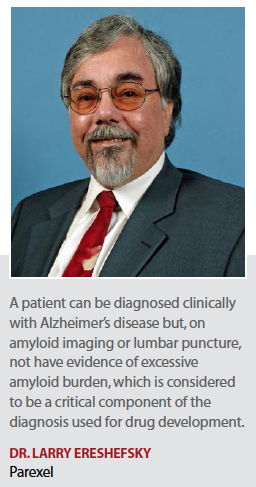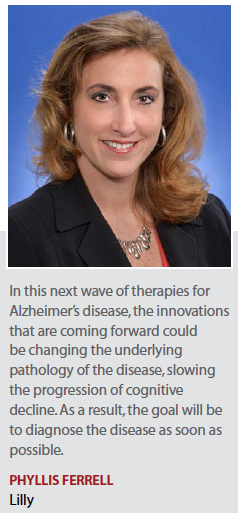 Neurological disorders comprise more than 600 conditions that affect the nervous system, impacting an estimated 50 million Americans every year. In the last few years, a tremendous push for new research of the brain has begun, in part, enabled by the National Institutes of Health BRAIN Initiative. Recent awards aim to develop new tools and technologies to understand neural circuits and have a more dynamic view of the brain.
Neurological disorders comprise more than 600 conditions that affect the nervous system, impacting an estimated 50 million Americans every year. In the last few years, a tremendous push for new research of the brain has begun, in part, enabled by the National Institutes of Health BRAIN Initiative. Recent awards aim to develop new tools and technologies to understand neural circuits and have a more dynamic view of the brain.
At the same time, researchers are looking for new ways to diagnose diseases of the brain. Imaging tools, such at CT, MRI, and PET scans, have made tremendous advances in the last decade.
But many of the more common CNS conditions are diagnosed clinically, with doctors assessing symptoms and patient reports.
“This is especially true in the psychiatry field," says Rebecca Evans, M.D., global therapeutic area head for CNS, at Parexel. “Major depression, schizophrenia, and bipolar disease are all clinical diagnoses, and there are no imaging or routine biomarker tests to assist with confirmation of these diagnoses. Additionally, these conditions can be quite heterogeneous in terms of etiology, disease course, and response to treatment. Once a patient is diagnosed, treatment can be a matter of trial and error, as we do not have an established process to determine who will best respond to a specific therapy."
There is now a wider range of tools for diagnosing neurological diseases. This includes an array of imaging tests — MRI, SPECT, and PET. Within MRI, there are specific ways to look at brain function.
 “With functional MRI, we can examine how the brain responds to a particular task performed by the patient," Dr. Evans says. “Nerve conduction velocities (NCV) and electromyography (EMG) are very useful for peripheral nerve conditions and muscle diseases. EEG is used in the diagnosis and treatment of epilepsy. Lumbar punctures to obtain spinal fluid are useful in a range of conditions, including CNS infections and dementia. Many research studies are collecting spinal fluid in various conditions to find new biomarkers that will aid in the diagnosis of conditions. For instance, work in Parkinson’s disease is ongoing."
“With functional MRI, we can examine how the brain responds to a particular task performed by the patient," Dr. Evans says. “Nerve conduction velocities (NCV) and electromyography (EMG) are very useful for peripheral nerve conditions and muscle diseases. EEG is used in the diagnosis and treatment of epilepsy. Lumbar punctures to obtain spinal fluid are useful in a range of conditions, including CNS infections and dementia. Many research studies are collecting spinal fluid in various conditions to find new biomarkers that will aid in the diagnosis of conditions. For instance, work in Parkinson’s disease is ongoing."
One newer tool for use in neurological disease is PET imaging with radiological tracers that can be detected. They have been used for diagnosing cancer, but newer tracers have been developed for neurology.
One example is Amyvid (Florbetapir F 18 Injection), which was approved by the Food and Drug Administration in 2012. Amyvid is a radioactive diagnostic agent indicated for PET imaging of the brain to estimate beta-amyloid plaque density in patients with cognitive impairment who are being evaluated for Alzheimer’s disease and other causes of cognitive decline. Amyvid binds to amyloid plaques and is detected using PET scan images of the brain.
The product was developed by Lilly’s subsidiary Avid Radiopharmaceuticals.
“Amyvid is able to cross the blood-brain barrier where it binds to beta-amyloid plaques," says Misty Long, clinical marketing at Siemens Healthcare. “Amyvid contains a radio labeled tracer called fluorine F18 isotope and it produces a positron signal that can be detected by our PET scanners."
Physicians, she says, are using the PET scan with Amyvid as an adjunct to other diagnostic evaluations.
“Amyvid can be used as one piece of the puzzle for evaluation for patients with cognitive impairment," she says. “These patients are being evaluated for Alzheimer’s disease or other causes of cognitive decline, when memory issues are of concern."
Additionally, tools such as ERP, QEEG, and cerebrospinal fluid biomarkers can be used to support the diagnosis of neurology diseases, says Larry Ereshefsky, Pharm.D., VP, early phase and therapeutic lead, CNS, Parexel.
“For instance, there are changes in cerebrospinal fluid in those who have Alzheimer’s disease," he says. “High levels of brain amyloid resulting in low CSF concentrations along with high levels of tau are consistent with a diagnosis of Alzheimer’s disease. Simultaneously, there are challenges related to biomarker-based diagnostics. A patient can be diagnosed clinically with Alzheimer’s disease but not demonstrate evidence of excessive amyloid, which is considered a critical component of the disease. These patients might not be expected to respond to amyloid lowering therapies, if and when such therapies are approved."
 Dr. Ereshefsky says the evolution of diagnosis for Alzheimer’s disease and the associated spectrum of the disease — preclinical, mild cognitive impairment, through to dementia — has moved toward a biomarker-based strategy to confirm the diagnosis.
Dr. Ereshefsky says the evolution of diagnosis for Alzheimer’s disease and the associated spectrum of the disease — preclinical, mild cognitive impairment, through to dementia — has moved toward a biomarker-based strategy to confirm the diagnosis.
“The International Working Group has recommended — and the EMA has accepted — that, for clinical registration trials, the diagnosis includes evidence of amyloid burden by either CSF sampling or amyloid PET imaging," he says. “In the United States, the diagnosis may still be made by clinical criteria; however, the research diagnostic guidelines applicable for registration trials also require biomarker evidence of underlying pathogenic mechanisms."
Dr. Evans points out that there should be a distinction between diagnostic biomarkers and prognostic biomarkers, which some CNS researchers are pursuing.
Prognostic biomarkers would assist in projecting the course of a disease.
“For instance, in relapsing remitting multiple sclerosis (MS), some patients have a benign disease course and others a rapidly worsening course," she says. “A prognostic marker for disease course would help in selecting the best therapy for a particular patient. For instance, a neurologist would suggest a drug that has greater efficacy in reducing the numbers of white matter lesions and delaying disability progression be used early in the disease course to treat a patient whose biomarkers suggested risk of rapid progression and development of significant disability. These drugs with greater efficacy, however, tend to have increased risks of serious adverse effects due to immunosuppression. Hence, a prognostic biomarker would assist in the decision making to use such drugs appropriately and not subject a patient to undue risk of serious side effects.
New CNS Diagnostics Needed
The identification of biomarkers has been driven by new technologies, including proteomics, next-gen sequencing, high throughput gene expression analyses, and metabolomic studies. One of the newest areas of biomarker research is in the CNS area. The hope is that some CNS conditions will eventually be diagnosed through a blood or urine test. That research, however, is still in its infancy.
“There have been several publications that have shown the identification of blood-based and other metabolic-based biomarkers for CNS conditions," says Amar Thyagarajan, Ph.D., senior product manager, at Taconic Biosciences. “Exactly how predictable and translatable to humans they are still remains to be seen from a disease onset and disease progression stand point. This will take time, but I’m very optimistic."
In every category of medicine, there’s a role for different protein markers at a level of sensitivity that no medicine or science has ever seen before, says Kevin Hrusovsky, executive chairman and CEO of Quanterix.
“There are about 1.1 million proteins in the body, and to date, there are only 4,000 serum proteins that are being used for diagnostic purposes," he says. “Much of this has to do with not being able to measure the serum proteins in low concentrations."
Dr. Thyagarajan says developing biomarker-based diagnostics for CNS conditions can be challenging for several reasons. One issue is that because of the species difference, biomarkers identified in animals may not always translate to human disease in terms of predicting disease states. One viewpoint to address this issue is that maybe this is not a one-way forward translation process.
“It is important to consider an iterative process involving both forward translation from animals to humans and backward translation of clinical information being further explored in animals," he says.
 Researchers and biopharmaceutical companies continue to research various ways to more accurately identify and diagnose CNS conditions.
Researchers and biopharmaceutical companies continue to research various ways to more accurately identify and diagnose CNS conditions.
“In Alzheimer’s disease, clinical diagnosis becomes less and less accurate the milder the symptoms are," says Eric Siemers, M.D., a distinguished medical fellow of Alzheimer’s disease global team at Lilly. “For moderate dementia, clinicians are accurate when diagnosing Alzheimer’s 90% of the time. But when we look to diagnose mild dementia, clinicians are wrong, based on diagnostic biomarkers, about 25% of the time. For Parkinson’ disease, there is the same problem of making sure the diagnosis is correct 100% of the time."
Dr. Siemers says accurate diagnoses will become critical when disease-modifying drugs become available.
“For Alzheimer’s disease, early diagnosis will become extremely important when disease-modifying treatments that are based on amyloid or a beta become approved," he says. “These treatments aren’t yet available, but when they are there is likely to be little debate about the value of these diagnostics."
Biomarker Testing
The global CNS biomarker market is projected to reach $5.1 billion by 2020 from $3.1 billion in 2015, a CAGR of 10.4%, according to BCC Research. Market drivers include the increase in public-private partnerships with government support, pressure to keep healthcare costs down, a growing elderly population, and the rapid advancement of genomic and proteomic technologies.
The CNS drug development segment is expected to see the fastest growth, increasing from $303 million in 2015 to $776 million by 2020 with a five-year CAGR of 20.7%. This large increase is due to the number of new compounds entering the clinic from discovery activities in company pipelines.
Tests for Alzheimer’s disease, schizophrenia, and multiple sclerosis are expected to be key components of the market in the next few years. These disorders represent large markets and have unmet needs in both diagnosis and treatment.
In January 2016, Lilly announced it was collaborating with Roche Diagnostics on its ongoing development of a commercially scalable cerebrospinal fluid assay for amyloid-beta 1-42. The test will combine Lilly’s reagent and antibodies that were used in clinical research with Roche’s kit.
Lilly and Roche have been collaborating for a while on the antibody reagents Lilly uses in clinical trials, says Phyllis Ferrell, VP of Lilly’s Alzheimer’s disease platform.
“This is basically an extension of that collaboration and taking what we are doing in clinical trials and making it commercially scalable," she says. “It is a stand-alone diagnostic, which is why the deal is not exclusive. The goal is to bring together the expertise that Lilly has from a similar diagnostic in clinical trials with Roche’s diagnostic and manufacturing footprint."
The diagnostic being developed by Roche uses the antibodies that Lilly developed as reagents for an ELISA assay that is being used in the ongoing clinical trials of the company’s potential Alzheimer’s therapy, solanezumab.
“When we started to think about the launch of solanezumab and the scale that would be needed for the diagnostics, that is when adding a collaboration with Roche to our current efforts using amyloid PET imaging made a lot of sense," Dr. Siemers says.
Lilly also is continuing its research of the monoclonal antibody solanezumab, which has shown an impact among early-stage patients. In March, the company announced a change to the primary endpoint for the Expedition3 clinical trial, a Phase III study of solanezumab in people with mild Alzheimer’s dementia.
The original study design included co-primary endpoints of cognition and function. Emerging evidence supports the idea that cognitive decline precedes and predicts functional decline in Alzheimer’s disease, particularly in earlier stages of the disease. Lilly has changed the trial to include a single primary endpoint of cognition. The functional outcomes are now secondary endpoints for the study.
Ms. Ferrell says the collaboration aims to provide another option for Alzheimer’s diagnosis.
“In this next wave of therapies, the innovations that are coming forward are disease modifying compounds or those that could actually slow the progression of Alzheimer’s disease," she says. “In that case, the goal will be to diagnose the disease as soon as possible. Right now, the Alzheimer’s Association says 50% of patients go undiagnosed and of the 50% who are diagnosed, half are at the moderate phase. If patients are not being diagnosed until those late stages, the benefit of a disease-modifying agent that slows the progression is diminished."
Ms. Ferrell says Lilly’s goal in this partnership is to give doctors a tool to diagnose the disease as early symptoms start occurring.
“We have other partnerships with the same goal in the manufacturing and distribution of the imaging agent Amyvid," she says. “We are excited to add Roche to these partnerships as we all have a common goal — the right patient, the right drug, every time."
Alternative Tests
One company working to develop a blood test is Quanterix. In March, Quanterix announced that its single molecule array technology Simoa has applications for a promising new brain biomarker never before measured in blood, referred to as neurofilament light (NFL), which was shown to be indicative of neuronal injury in a variety of neurodegenerative conditions. One of the limitations of NFL is the requirement of a lumbar puncture to obtain cerebrospinal fluid. For this reason, a sensitive and reliable blood biomarker to detect CNS injury would represent a welcome advance in both clinical and research settings. Using Quanterix’ Simoa technology, researchers developed an assay to determine whether plasma concentrations of NFL might be used to measure NFL in serum. The results showed a strong correlation between the marker and disease pathology, which suggests that plasma NFL may prove a valuable tool to help detect the onset of disease before symptoms are present.
Researchers Kaj Blennow and Henrik Zetterberg used the NFL biomarker to demonstrate that the protein increased over the course of a season among collegiate football players compared with a control group from a non-contact sport, showing NFL’s utility as a marker of head injury.
The company’s technology has the potential to change both research and diagnostics for brain injuries such as concussions, neurodegenerative diseases such as chronic traumatic encephalopathy (CTE), and CNS diseases, such as Alzheimer’s.
“NFL is a very important protein that has been demonstrated to be linked to the symptoms of dementia," Mr. Hrusovsky says. “Over the course of several different publications, there’s been strong correlative evidence that the higher the level of NFL in cerebrospinal fluid in the brain, the higher the level of that NFL would be in blood, in the past the levels couldn’t be detected in blood because of the lower concentration."
Quanterix’ breakthrough is in the ability not only to detect proteins that couldn’t be detected previously in blood, but also to be able to show a correlation with different cohorts with greater levels of dementia.
“These are important breakthroughs as we continue to build a body of evidence that our technology can be one of the first to measure brain health through blood biomarkers," Mr. Hrusovsky says. “There is a great deal of interest in being about to translate this science into effective tests, especially in the area of concussion tests."
Quanterix has a partnership with BioMérieux, which has the rights to bring the technology into in-vitro diagnostic labs. Quanterix also is working with reference labs, such as Quest and LabCorp and others, that aim to launch tests based on Quanterix’s work. Quanterix also is working with a large diagnostic company for the point-of-care diagnostics for blood screening and blood typing.
Mr. Hrusovsky says he expects a laboratory test to be available by the end of this year, and an in vitro diagnostic in 2018. (PV)


















